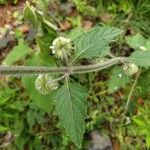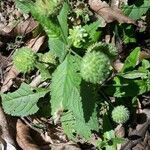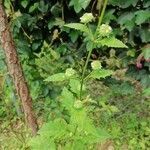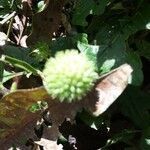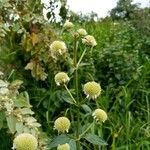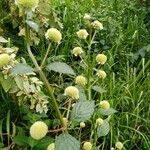Stout, erect annual herb, 0.5-2.5 m, not aromatic. Stem and branches (often very short) densely or sparsely pubescent on the angles. Leaves lanceolate or rhomboid-elliptic, 6-10(-14) by 1.5-4(-6) cm, acute or acuminate, base cuneate and decurrent; margin crenate-serrate or serrate, sparsely pubescent on the nerves of lower surfaces; petiole 2-3 cm. Flowers oo in crowded verticillasters forming axillary, solitary globular heads, 0.8-1 cm Ø (1.5-2 cm Ø in fruit); peduncle 3-5(-8) cm, basal involucral bracts linear-lanceolate, hairy, 3-6 mm long. Calyx 3-4 mm long, in fruit 6-8 mm; teeth subulate, erect, as long as or shorter than the tube. Corolla white, violet-dotted, 5-6 mm long. Anthers purple. Nutlets ovoid, compressed 1.2-2 mm long, round-truncate above, subtriquetrous below, sparingly puberulent, brown, pericarp not swelling when soaked in water.
A herb or shrub. It grows 1-2 m tall. The leaf bearing twigs are 4 angled. The leaves and twigs have a strong odour when crushed. The leaves are 6-14 cm long by 2-6 cm wide. The leaves are hairy and these are more obvious on the upper surface. The flowers are in dense round heads.
